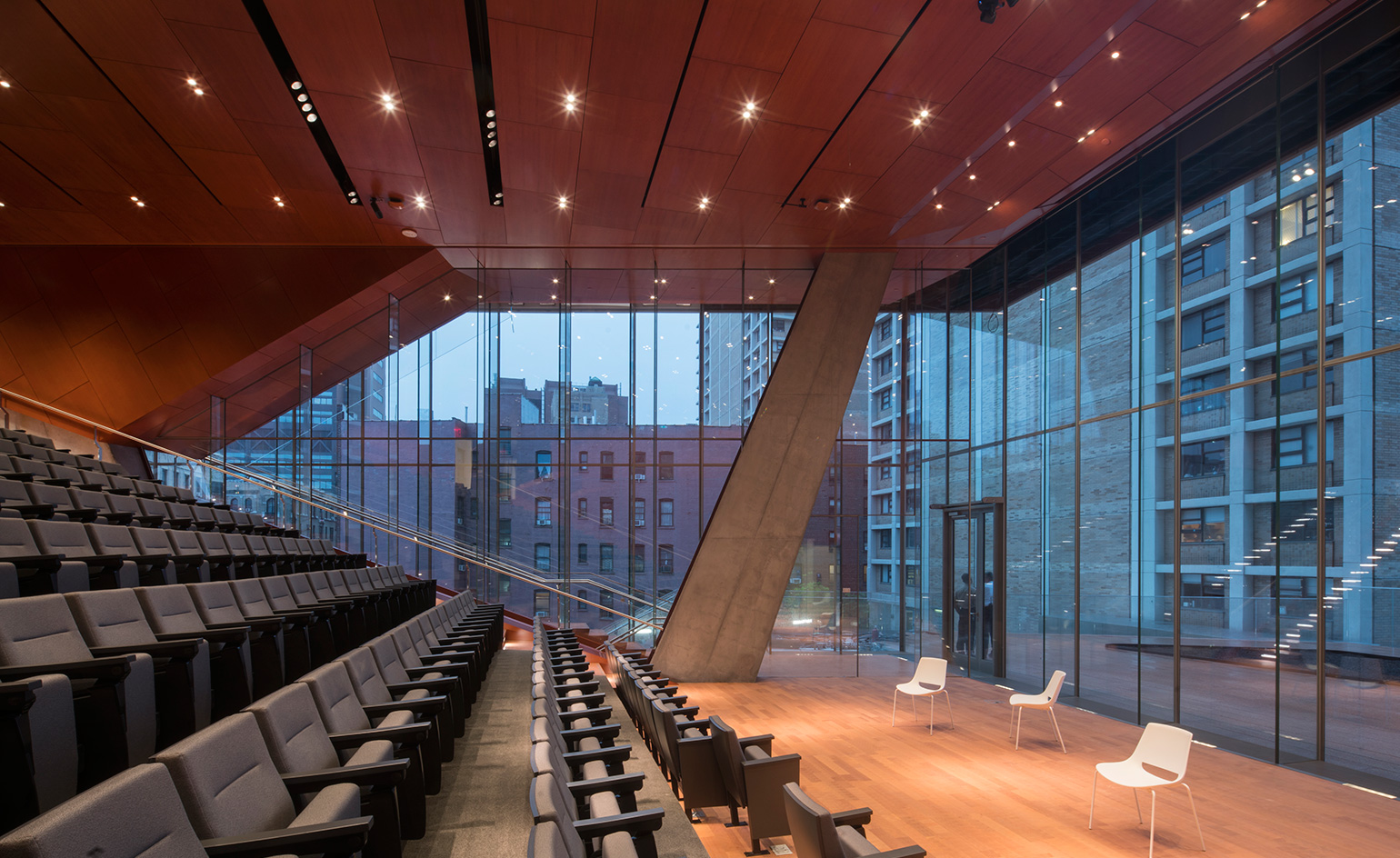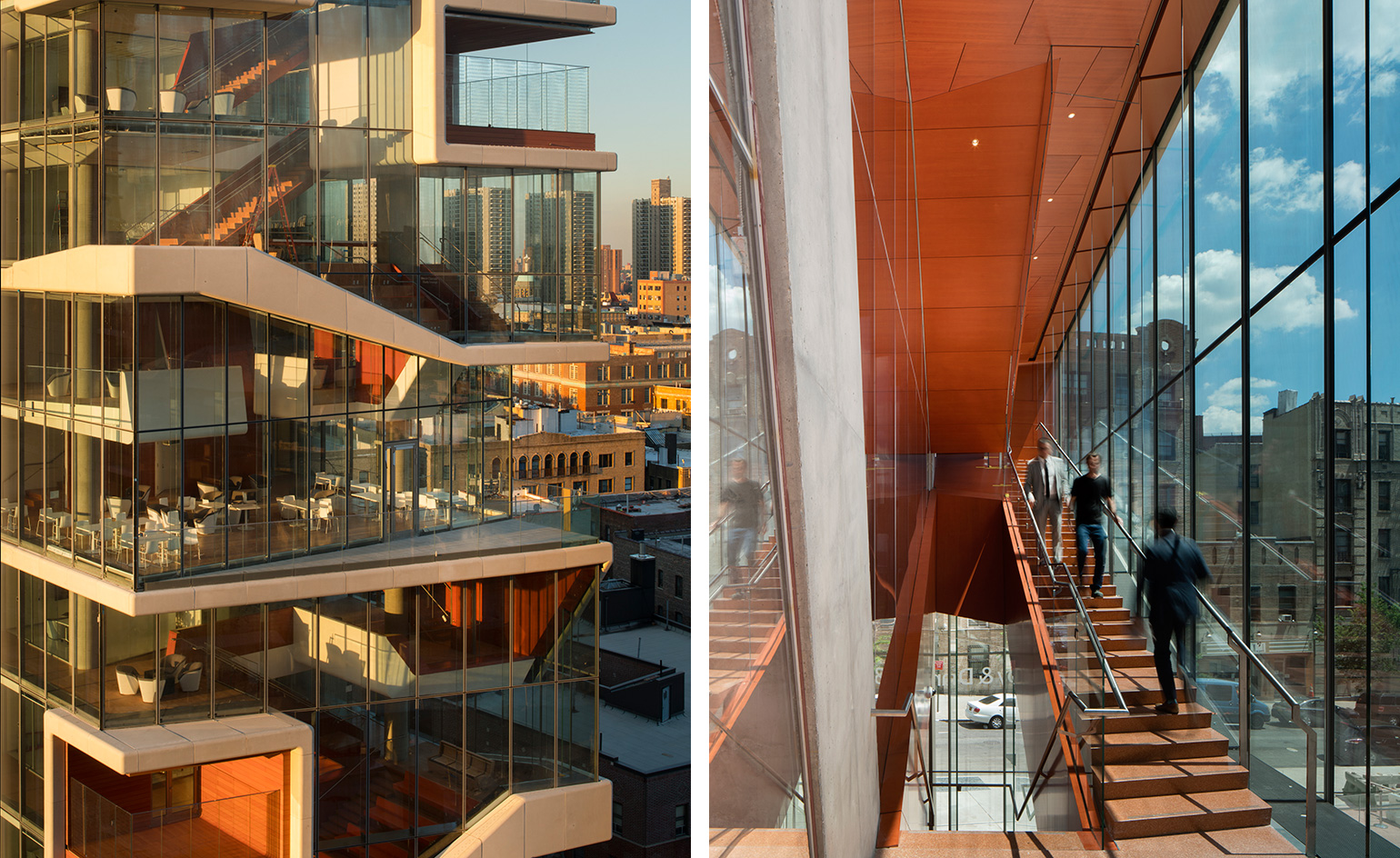Doctor’s orders: DS+R creates a light-filled Medical Center for Columbia University

Diller Scofidio + Renfro seems to be the architects du jour for Columbia University. Not only is it masterminding the lauded Business School; but first, its 14-storey, glass cascading Medical Center tower is unveiled just in time for the start of the fall semester.
The tower is both an education and graduate centre. After heavily weighed considerations taken on the part of the architects, says Elizabeth Diller, which worked in collaboration with the firm Gensler, the pristinely modern building is anchored to become the hub of medical student life at the university. According to Diller, the students were asked, 'Where they want to spend time?' Thus, the architects in turn created a 'building you don’t want to escape from'. The Center is flooded with light, exploiting 'views to the south, north and east, and a celebration of the site' and factoring state-of-the-art everything, including study sky lounges, like those of an arena or taller tower. Add in smart-glass ensconced common areas, and chances are the students won't ever want to leave.
While most medical students are trapped in residency rotation rounds or the fluorescent-dimmed aisles of the library, this new educational outpost is actually 'distinctly different', says Diller, who also points out that the typical medical educational facility tends to be boxy, low in height and clunky. 'This is a challenge of that,' she says. 'For the students, there is a correlation between space and learning.' And while the classrooms and learning spaces within the building offer the latest and best technological setups available, including flexible teaching spaces and a clinical simulation center, the 'heart of the building', in Diller’s eyes, is really the 10th floor student common area. When researching for the project, Diller came across an anatomy map of a snake, whose heart is in the middle of the body, which thus became the guiding principle behind the building’s logic – expressed through a snaking 'study cascade', which vertically links the interior spaces through the building's 14 floors.

Both an education and graduate centre, the pristinely modern building is set to become the hub of medical student life at the university

While most medical students are trapped in residency rotation rounds or the fluorescent-dimmed aisles of the library, this new educational outpost is actually ’distinctly different,’ says Elizabeth Diller

The classrooms and learning spaces within the building offer the latest and best technological setups available, including flexible teaching spaces and a clinical simulation centre

When researching for the project, Diller came across an anatomy map of a snake, whose heart is in the middle of the body, which thus became the guiding principle behind the building’s logic – expressed through a snaking ’study cascade’, which vertically links the interior spaces through the buildings 14 floors
INFORMATION
For more information, visit the Diller Scofidio + Renfro website
Receive our daily digest of inspiration, escapism and design stories from around the world direct to your inbox.
Julie Baumgardner is an arts and culture writer, editor and journalist who's spent nearly 15 years covering all aspects of art, design, culture and travel. Julie's work has appeared in publications including Bloomberg, Cultured, Financial Times, New York magazine, The New York Times, Wall Street Journal, as well as Wallpaper*. She has also been interviewed for The Atlanta Journal-Constitution, Miami Herald, Observer, Vox, USA Today, as well as worked on publications with Rizzoli press and spoken at art fairs and conferences in the US, Middle East and Asia. Find her @juliewithab or juliebaumgardnerwriter.com
-
 Click to buy: how will we buy watches in 2026?
Click to buy: how will we buy watches in 2026?Time was when a watch was bought only in a shop - the trying on was all part of the 'white glove' sales experience. But can the watch industry really put off the digital world any longer?
-
 Don't miss these art exhibitions to see in January
Don't miss these art exhibitions to see in JanuaryStart the year with an inspiring dose of culture - here are the best things to see in January
-
 Unmissable fashion exhibitions to add to your calendar in 2026
Unmissable fashion exhibitions to add to your calendar in 2026From a trip back to the 1990s at Tate Britain to retrospectives on Schiaparelli, Madame Grès and Vivienne Westwood, 2026 looks set to continue the renaissance of the fashion exhibition
-
 Step inside this resilient, river-facing cabin for a life with ‘less stuff’
Step inside this resilient, river-facing cabin for a life with ‘less stuff’A tough little cabin designed by architects Wittman Estes, with a big view of the Pacific Northwest's Wenatchee River, is the perfect cosy retreat
-
 Remembering Robert A.M. Stern, an architect who discovered possibility in the past
Remembering Robert A.M. Stern, an architect who discovered possibility in the pastIt's easy to dismiss the late architect as a traditionalist. But Stern was, in fact, a design rebel whose buildings were as distinctly grand and buttoned-up as his chalk-striped suits
-
 Own an early John Lautner, perched in LA’s Echo Park hills
Own an early John Lautner, perched in LA’s Echo Park hillsThe restored and updated Jules Salkin Residence by John Lautner is a unique piece of Californian design heritage, an early private house by the Frank Lloyd Wright acolyte that points to his future iconic status
-
 The Architecture Edit: Wallpaper’s houses of the month
The Architecture Edit: Wallpaper’s houses of the monthFrom wineries-turned-music studios to fire-resistant holiday homes, these are the properties that have most impressed the Wallpaper* editors this month
-
 The Stahl House – an icon of mid-century modernism – is for sale in Los Angeles
The Stahl House – an icon of mid-century modernism – is for sale in Los AngelesAfter 65 years in the hands of the same family, the home, also known as Case Study House #22, has been listed for $25 million
-
 Houston's Ismaili Centre is the most dazzling new building in America. Here's a look inside
Houston's Ismaili Centre is the most dazzling new building in America. Here's a look insideLondon-based architect Farshid Moussavi designed a new building open to all – and in the process, has created a gleaming new monument
-
 Frank Lloyd Wright’s Fountainhead will be opened to the public for the first time
Frank Lloyd Wright’s Fountainhead will be opened to the public for the first timeThe home, a defining example of the architect’s vision for American design, has been acquired by the Mississippi Museum of Art, which will open it to the public, giving visitors the chance to experience Frank Lloyd Wright’s genius firsthand
-
 Clad in terracotta, these new Williamsburg homes blend loft living and an organic feel
Clad in terracotta, these new Williamsburg homes blend loft living and an organic feelThe Williamsburg homes inside 103 Grand Street, designed by Brooklyn-based architects Of Possible, bring together elegant interiors and dramatic outdoor space in a slick, stacked volume